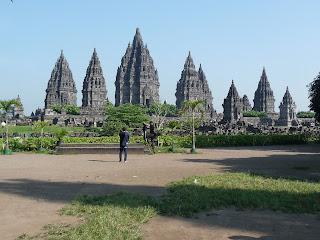On the morning of 12th June we left the hotel
at 5:30 AM for Denpasar domestic airport to join the Air Asia flight to
Yogyakarta. Yogyakarta is the capital of one of the administrative regions of
Java island of Indonesia. It is a
popular tourist place in Java due to its proximity to temples of Prambanan and
Borobudur. Pedalling rickshaws and
horse-drawn carts ply in this city besides taxis. This region has also been
affected by earthquakes and volcanic eruptions. As late as 2006, there was a
big earthquake near the city claiming more than 6000 lives. Prambanan temple bears the scars of the
earthquake. As late as 2010, the nearby volcano Mt. Merapi erupted spewing ash
all over the nearby villages. Borobudur
temple was also affected by the rain of volcanic ash. Though it is also known for its handicrafts
like Bali you can see the striking difference between the two even as you enter
the city. Tour driver Siddique greeted us with the vehicle at the airport. He can communicate in a limited way in
English. As English speaking guides at Prambanan temple, Borobudur temple and
Sultan’s palace were part of the tour charges, this did not much affect us.
Our first place of visit was Prambanan temple compound.
The guide here, Hari, was a well-informed person and he was easily the best
guide we met in the whole tour. The temple compound is situated in a park and
is about 17 kilometres from city centre. The temple compound is a UNESCO World
Heritage site. This is one of the biggest Hindu temple in Southeast Asia and
the largest Hindu temple site in Indonesia. In its heyday in 10th century the
compound is said to have housed nearly 240 temples, major and minor and now we
have only 6 major temples devoted to Trimurthy i.e. Siva, Vishnu, and Brahma and
their Vahanas Nandi, Garuda and Hamsa
besides 7 small shrines. The
temple complex consists of three zones, the innermost the holiest zone contain
the temples for Trimurthy besides other shrines. These are also reconstructed temples as the
original temples collapsed in an earthquake in 16th century and we
can see boulders and carvings strewn all over. The temples were again damaged
during the 2006 earthquake and was closed to visitors for some time for repairs.
Of
these the tallest and and most important temple is that of Siva Mahahadeva, the
ParaBrahman. In fact this word
ParaBrahman has been corrupted as Prambanan.
The Shiva temple is the tallest and largest structure in Prambanan
complex. It is around 47 meters i.e.150 ft. high and it is quite a climb to
reach the main shrine. Besides the main
shrine for Lord Siva, there are also shrines for Goddess Durga, Lord Ganesa and Sage Agasthya,
whom they believe as Guru of Lord Siva. This temple is equipped with galleries where
the story of Ramayana is carved on the inner walls. We can follow the story when we do outer
pradakshina of the inner shrines. For the other temples also you have to climb
a number of steps though not as much as in this temple. The temples for Lord Vishnu and Lord Brahma
are of lesser height and each has one shrine only. The temples for vahanas are
of still lesser height and they face their respective main temples. After climbing the steps of temples for Trimurthy
and of Nandhikeswar, we had no mind to explore others, as we had to conserve energy
for climbing the steps in Borobudur.
From Borobudur temple we went to two other Buddhist
temples nearby which are said to have a ritual relationship with the main
temple of Borobudur. These are also at a height and a flight of stairs have to
be negotiated to reach the top. In Pawon
temple there was no idol in the shrine at the top and we could see only the
carvings of Bodhisattvas, kinnara-kinnari and Kalpataru in the outer walls. In
the Mendut temple we could see the three metre tall Buddha seated on a throne flanked
by two Bodhisattvas besides the beautiful carvings in the outer wall. There is a nice garden attached to this
temple and also a monastery which seems to be a recent building. At the front
of the building is a large statue of sleeping Buddha and at the back a statue
of Buddha sitting in padmasana before a Stupa. It was very calm and
peaceful there, ideal for meditation, but we didn't see any monk there. We were told Chanting takes place every day there in the late evening. From Mendut
temple we made our return to Yogyakarta where we had our dinner and proceeded
to airport to catch the night flight to Denpasar. We reached our hotel at 12 p.m. in the night,
to rest after a tiring day of pleasant memories.



No comments:
Post a Comment